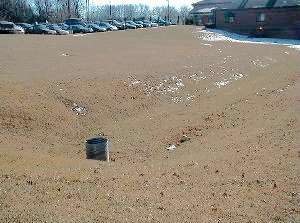Infiltration basin
An infiltration basin (also known as a recharge basin or in some areas, a sump[1] or percolation pond[2]), is a type of device that is used to manage stormwater runoff, prevent flooding and downstream erosion, and improve water quality in an adjacent river, stream, lake or bay. It is essentially a shallow artificial pond that is designed to infiltrate stormwater through permeable soils into the groundwater aquifer. Infiltration basins do not release water except by infiltration, evaporation or emergency overflow during flood conditions.[3][4][5]

It is distinguished from a detention basin, sometimes called a dry pond, which is designed to discharge to a downstream water body (although it may incidentally infiltrate some of its volume to groundwater); and from a retention basin, which is designed to include a permanent pool of water.
Design considerations
Infiltration basins must be carefully designed to infiltrate the soil on a given site, at a rate that will not cause flooding. They may be less effective in areas with:
- high groundwater levels, close to the infiltrating surface;
- compacted soils;
- high levels of sediment in stormwater; or
- high clay soil content.[6]
At some sites infiltration basins have worked effectively where the installation also includes an extended detention basin as a pretreatment stage, to remove sediment.[7] The basins may fail where they cannot be frequently maintained, and their use is discouraged in some areas of the United States. For example, they are not recommended for use in the U.S. state of Georgia, which has many areas with high clay soil content, unless soil on the particular site is modified ("engineered soil") during construction, to improve the infiltration characteristics.[8]
See also
- Dry well
- French drain
- Percolation trench
- Rain garden
- Sustainable urban drainage systems
- Septic drain field
- Tree box filter
References
- Fagin, Dan (2007). "Ancient, Clean, Controversial: Preserving deep reserves of water is LI's chief environmental issue" (PDF). Newsday. Melville, NY.
- "Water Portal / Rainwater Harvesting / Groundwater recharge / Infiltration ponds".
- Pekarek, Kathryn A.; et al. (2011). Stormwater Management: Terminology (PDF) (Report). University of Nebraska-Lincoln. p. 7. EC701. Extension Circular.
- New Jersey Department of Environmental Protection. Trenton, NJ."New Jersey Stormwater Best Management Practices Manual." Archived 2008-05-13 at the Wayback Machine Chapter 9.5: Standard for Infiltration Basins. April 2004.
- "Ch. 5: Description and Performance of Storm Water Best Management Practices". Preliminary Data Summary of Urban Storm Water Best Management Practices (Report). Washington, D.C.: U.S. Environmental Protection Agency (EPA). August 1999. EPA-821-R-99-012.
- Water Environment Federation, Alexandria, VA; and American Society of Civil Engineers, Reston, VA. "Urban Runoff Quality Management." WEF Manual of Practice No. 23; ASCE Manual and Report on Engineering Practice No. 87. 1998. ISBN 1-57278-039-8. Chapter 5.
- Clar, Michael L.; Barfield, Billy J.; O'Connor, Thomas P. (2004). "Pretreatment". Stormwater Best Management Design Guide; Volume 3: Basin Best Management Practices (Report). EPA. pp. 4–8. EPA 600/R-04/121B.
- Atlanta Regional Commission; et al. (2016). "Infiltration Practices". Georgia Stormwater Management Manual, Volume 2 - Technical Handbook (Report). pp. 247–252.
External links
- Maryland Stormwater Design Manual - See Section 3.3 for Infiltration Feasibility Criteria & Design Diagrams
- International Stormwater BMP Database - Performance Data on Urban Stormwater Best Management Practices
- Stormwater management Tools: